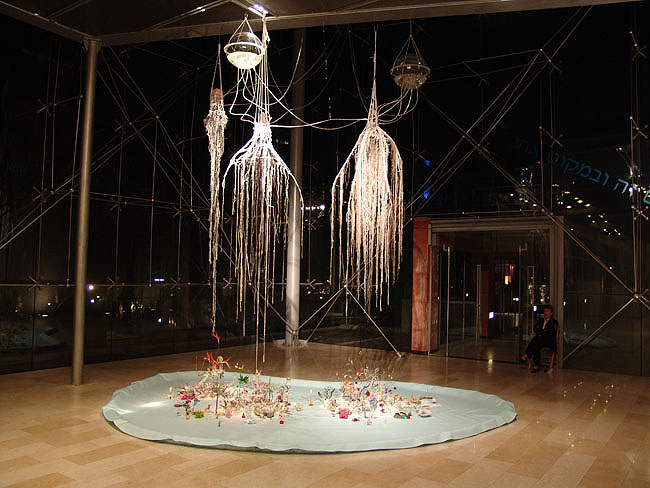
|
Wurzelbehandlung Tel Aviv Museum of Art, 2004 Von tief unten schauen wir den feucht glänzenden und tropfenden Wurzeln entlang hinauf in den dunklen Raum. Nein, wir sind nicht tot. Wir stehen im untersten Geschoss des ‹Sarah Racine› Wurzellabors im Botanischen Garten auf dem Gelände der Universität Tel Aviv. Die Pflanzen sitzen im 4. Stock, ihre Wurzeln können sich widerstandslos bis zu 6 Meter in die Tiefe entfalten und mit Wasser und Dünger wachsfreudig gehalten werden (Aeroponic-Kultur). Die ursprüngliche Idee, diese Kultivierungsmethode zur Produktion von Lebensmitteln einzusetzen, wurde fallen gelassen: Das Besprühen der Wurzeln mit Wasser und Dünger erfordert einen keimfreien Raum (damit zum Beispiel keine Pilze wachsen) und eine zu aufwändige Technologie, um Projekte im grösseren Stil zu realisieren. Das Labor hat uns drei seiner Wurzelstöcke gegeben, damit wir sie im Tel Aviv Museum of Art einer Wurzelbehandlung unterziehen können. Wasser und Salz ergeben die Lösung, welche über die Wurzeln tropft und sie langsam mit einer weissen Salzkruste überzieht. Gleichzeitig beginnen an den Wurzelenden feine Stalaktiten zu wachsen. Der Rest des Salzwassers tropft auf eine Landschaft aus Kunstpflanzen, Steinen vom Toten Meer und Häkeldecken (vom Flohmarkt in Jaffa), auf denen das Salz wie Schneekristalle erblüht. Nach ein paar Monaten berühren die Wurzeln den Garten. Alle Lebewesen sind auf Salz angewiesen, um existieren zu können. In konzentrierter Form hingegen wirkt Salz tödlich und konservierend. Nicht nur in Israel hat die Versalzung der Böden infolge zu intensiver Landwirtschaft fatale Konsequenzen. In Zukunft werden die Menschen auf Pflanzen, die auch bei hohen Salzkonzentrationen gedeihen, angewiesen sein. |
Root Treatment Tel Aviv Museum of Art, 2004 From deep down we gaze up along the damp glistening and dripping roots into the dark space above. No, we are not dead. We are standing on the lower floor of the “Sarah Racine” root laboratory in the Botanic Garden on the grounds of Tel Aviv University. The plants are on the 4th floor, but their roots can grow downwards unimpeded for about 6 meters, and their growth is being promoted with water and fertilizer (aeroponic culture). The original idea of using this method of cultivation to produce foodstuffs was dropped because spraying the roots with water and fertilizer requires a sterile room (so that, for example, no fungus can grow) and the technology is too complex for larger-scale projects to be feasible. The laboratory gave us three of its roots so that we could subject them to a root treatment at the Tel Aviv Museum of Art. The solution that drips down along the roots, slowly covering them with a salty white crust, is made of water and salt. At the same time, fine stalactites begin to grow on the ends of the roots. The remainder of the salt water drips onto a landscape made up of artificial plants, stones from the Dead Sea and crochet covers (from the flea-market in Jaffa) on which the salt blossoms like snow crystals. After a few months, the roots reach the garden. All living things depend on salt to exist. Yet in concentrated form salt is both deadly and a preservative. The salinization of the earth as a result of intensive agriculture has had fatal consequences, not only in Israel. In future, people will be reliant on plants that flourish even in high concentrations of salt. |